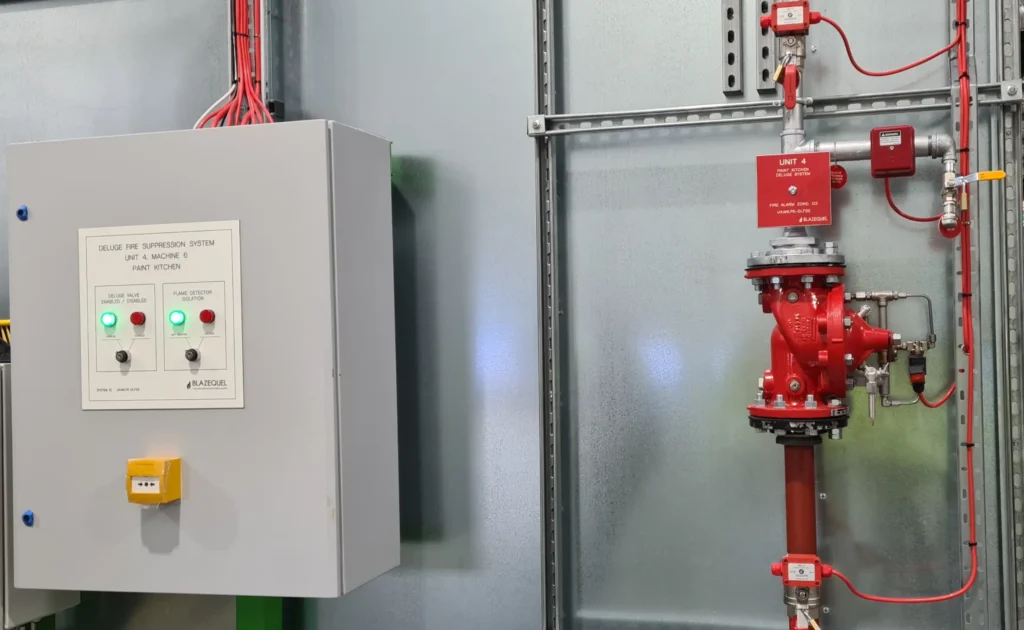
Fire Sprinkler Systems
Fire Sprinkler systems are a very effective and reliable way to protect almost any building or asset from fire. They
Kitchen Fire Suppression system is an automatic solution. It is designed to protect your cooking appliances and extract ducting in the event of a fire.
It is often a requirement in commercial kitchens to have an extraction hood suppression system. because this is where a fire is most likely to happen.
We normally, install a firefighting system which uses a wet chemical agent. Pressurized detection tubing is placed around the cooker hood. This melts at a pre-set temperature, releasing pressure within the tube and thus opening the valve in the extinguishant cylinder.
This then forces the extinguisher medium through the nozzles onto the fire. Normally they need to be checked on a six-monthly basis. Each one needs to be designed according to the open cooking devices below the hood, such as hobs, deep fat fryers and grills.
A video of kitchen fire suppression system in action
Your Kitchen Fire Suppression system will include the following components:
Contact us now to learn more about Blazequel kitchen fire suppression and how they can be an essential part of your fire safety plan.
Kitchen fire extinguishers are designed to handle fires that are common in cooking areas, such as fat fires. They often use a different type of extinguishing agent that is effective against cooking oils and fats.
Class F fire extinguishers are specifically designed for kitchen fires involving cooking oils and fats. They use a special wet chemical agent that reacts with the oil to create a soapy foam, cooling the fire and preventing re-ignition.
While a regular ABC fire extinguisher can be used in the kitchen, it will not be as effective against fat fires. It’s recommended to have a Class F fire extinguisher in the kitchen for better coverage.
Regularly check your kitchen fire extinguisher at least once a month. Ensure that the pressure gauge indicates it is charged, and inspect for any visible signs of damage or wear. Also, check the expiration date, as fire extinguishers have a limited lifespan.
Yes, a fire extinguisher can be used on small fire involving electrical equipment in the kitchen, but it’s important to use a non-conductive extinguishing agent. A CO2 fire extinguisher is suitable for this.
Remember the acronym “PASS”: Pull the pin, Aim the nozzle at the base of the fire, Squeeze the handle, and Sweep from side to side. Stand at a safe distance and approach the fire cautiously.
After using a fire extinguisher, there may be residue to clean up. Follow the manufacturer’s instructions for cleanup, which often involve wiping away the residue with a damp cloth. Ensure proper ventilation during and after cleanup.
Not all fire extinguishers are rechargeable. Check the label or instructions on your extinguisher. If it is rechargeable, have it recharged by a professional if used, even partially. If it’s not rechargeable, you may need to replace it.
Install your kitchen fire extinguisher in a visible and easily accessible location, preferably near the kitchen exit. Avoid placing it near cooking appliances to ensure safe access during a fire.
Don’t hesitate to reach out to us, or you can easily fill out the form below. We’re here to assist you.


Fire Sprinkler systems are a very effective and reliable way to protect almost any building or asset from fire. They

water cannons are fixed position fire extinguishing nozzles that can be used to directly target a fire at your facility.

brilliant solution for high-risk areas, where the sometimes-slow reaction speed of sprinkler systems will allow too long for the fire